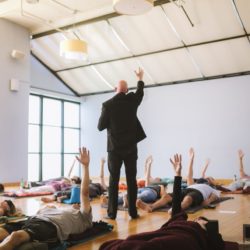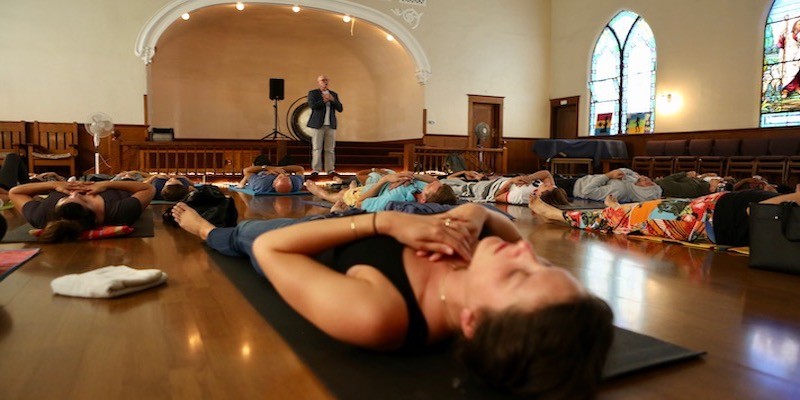Why Do My Hands Curl When I’m Hyperventilating During Breathwork?
Jon Paul Crimi, Tanya GK Bentley, PhD
During active breathwork practices, some people experience hyperventilation and their hands curl or they have cramping and tightness in the hands or around the mouth. Known as tetany and described by many as “lobster claw” hands, this phenomenon can occur in different types of breathwork such as holotropic, rebirthing, transformational, Wim Hof Method (WHM), and others.
Many breathwork teachers explain tetany as caused by holding onto unconscious, “stuck” energy or the need for control. Solutions involve spiritual self-exploration such as asking what we’re holding onto or exploring our fears.
Since these explanations never satisfied us, we did some investigating and discovered scientific answers that – in our opinions – make more sense.
Simply said, tetany is the involuntary contraction of muscles that occurs when CO2 decreases significantly in the body. This can happen during breathwork when we hyperventilate and breathe really fast or exhale too forcefully or too much – so the rate or volume of breathing eliminates more CO2 then the body can produce.(1)
Tetany is more likely in people with underlying mineral imbalances, including:
- Low magnesium (2,3,4,5) – more likely during pregnancy(6) or lactation, use of diuretics, or high alcohol consumption (4)
- Low potassium (12,7)
- Parathyroid hormone (PTH) deficiency (8,9)
- Excess phosphate10
- Low calcium
- Electrolyte deficiencies due to long-term inhaler use (i.e., for asthma or COPD) (12)
How can you avoid this or help those you teach to avoid it?
- During breathwork: slow down the breathing, reduce the forcefulness or duration of exhales (just lightly “let go” of breath), move/massage hands or other body parts experiencing tetany
Outside of breathwork:
- Consider whether any of above mineral imbalances may be applicable.
- Get checked for these imbalances if high-risk (e.g., pregnant or lactating, on diuretics, high alcohol intake, long-term inhaler use).
**For the science geeks like Tanya who need a little more detail:
- Low CO2 causes tetany because it reduces cellular calcium and increases blood PH. (9,11)
- Sodium leaks into nerve cells and makes them hyper-excitable, resulting in tingling and – when more
extreme – muscle spasms in the extremities and around the mouth. (12,4)
Thanks for reading about tetany and breathwork!
References and Sources
- Booth DI. The effect of breathing techniques on the end-tidal percentage of carbon dioxide and its importance during labor. Aust J Physiother. 1967 Sep;13(3):110-2.
- Vallee BL, Wacker WE, Ulmer DD. The magnesium-deficiency tetany syndrome in man. N Engl J Med. 1960 Jan 28;262:155-61.
- Zimmet P. Role of magnesium in tetany. N Engl J Med. 1968 Jul 11;279(2):109-10.
- Williams A, Liddle D, Abraham V. Tetany: A diagnostic dilemma. Journal of Anaesthesiology, Clinical Pharmacology. 2011;27(3):393-394.
- Fehlinger R, Seidel K. The hyperventilation syndrome: a neurosis or a manifestation of magnesium imbalance? Magnesium. 1985;4(2 3):129-36.
- Some forms of breathwork are contra-indicated during pregnancy; it is recommended that pregnant women talk to their physicians and breathwork teachers before doing breathwork.
- Moon HS, Lee SK, Chung JH, In CB. Hypocalcemia and hypokalemia due to hyperventilation syndrome in spinal anesthesia -A case report-. Korean Journal of Anesthesiology. 2011;61(6):519-523.
- Hans SK, Levine SN. Hypoparathyroidism. [Updated 2017 Oct 8]. In: StatPearls [Internet]. Treasure Island (FL): StatPearls Publishing; 2018 Jan. Available from: https://www.ncbi.nlm.nih.gov/books/NBK441899/, accessed April 2018.
- Edmondson JW, Brashear RE, Li TK. Tetany: quantitative interrelationships between calcium and alkalosis. Am J Physiol. 1975 Apr;228(4):1082-6.
- Kassirer JP. Editorial: Hyperphosphatemia, hyperparathyroidism and bighead. N Engl J Med. 1973 Dec 20;289(25):1367-8.
- Macefield G, Burke D. Paraesthesiae and tetany induced by voluntary hyperventilation. Increased excitability of human cutaneous and motor axons. Brain. 1991 Feb;114 ( Pt 1B):527-40.
- Parasa M, Saheb SM, Vemuri NN. Cramps and tingling: A diagnostic conundrum. Anesth Essays Res. 2014 MayAug;8(2):247-9
Tanya GK Bentley PhD contact info:
Instagram: tanyabentley
Facebook: Tanya.G.Bentley
LinkedIn: Tanya G.K. Bentley




